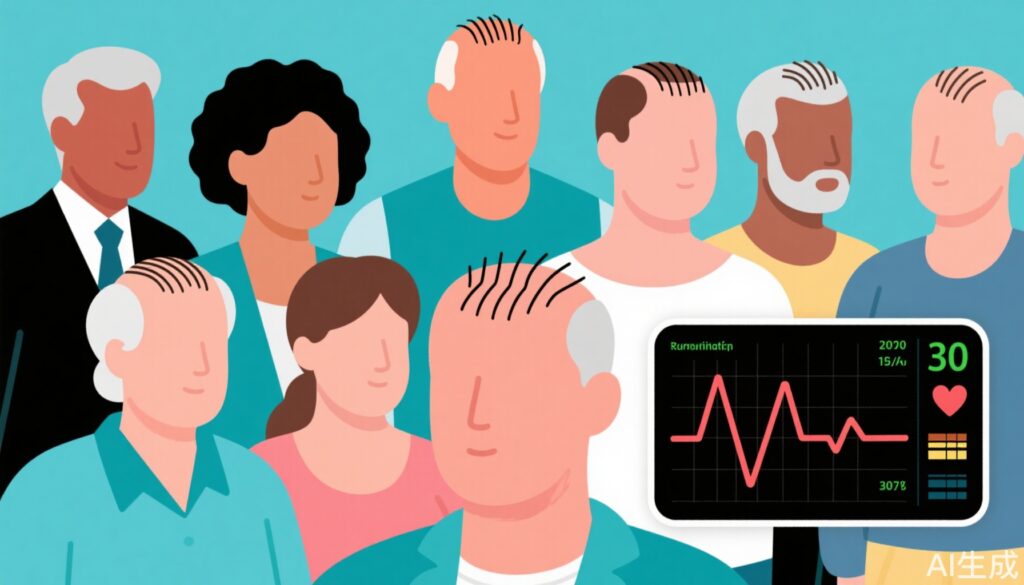Highlight
– Low-dose oral minoxidil (LDOM) not linked to increased tachycardia risk in over 9,000 patients treated for nonscarring alopecia.
– Study involved a large cohort of 524,522 patients excluding those with prior hypertension, tachycardia, or arrhythmia.
– Risk of tachycardia was lower in men and Asian patients, but higher in Black and White patients regardless of LDOM usage.
– Findings support cardiac safety of LDOM in patients without cardiac risk factors, suggesting beta-blocker coadministration is unnecessary.
Study Background and Disease Burden
Androgenic alopecia and other nonscarring hair loss disorders affect a substantial proportion of the adult population worldwide, impacting quality of life and self-esteem. Oral minoxidil, initially developed as an antihypertensive agent, has been repurposed at low doses (≤5 mg/day) off-label to stimulate hair regrowth. Despite its efficacy, concerns persist about cardiovascular side effects, notably tachycardia, due to minoxidil’s vasodilating properties and known use at higher doses for hypertension. Hence, comprehensive safety data evaluating tachycardia risk in patients treated with low-dose oral minoxidil are needed to guide clinical practice.
Study Design
This retrospective cohort study utilized the TriNetX database, encompassing electronic health records from 2004 to 2024, analyzing 524,522 patients diagnosed with androgenic alopecia or other forms of nonscarring alopecia. Patients with a history of hypertension, tachycardia, or arrhythmia were excluded to isolate LDOM effects in low cardiac risk individuals. Within this population, 9,267 patients received low-dose oral minoxidil (≤5 mg daily) off-label for hair loss treatment, while the remaining patients were untreated controls (minoxidil-naïve).
Demographic differences included that the LDOM group was older (mean age 45.5 vs 39.8 years, P < .0001) and had a higher proportion of men (33% vs 19%, P < .0001). The primary endpoint was the incidence of tachycardia diagnosed post-initiation of treatment, with the median time to diagnosis in the LDOM group being 245 days.
Key Findings
Among the patients receiving LDOM, 126 (7.7%) were diagnosed with tachycardia. The hazard ratio (HR) for developing tachycardia with LDOM versus controls was 0.90 (95% CI, 0.76-1.08), indicating no significant increase in risk associated with low-dose minoxidil treatment. Adjusted analyses also confirmed no association between LDOM and tachycardia (HR, 0.92; 95% CI, 0.77-1.10).
Stratified analyses revealed that men had a significantly lower likelihood of tachycardia compared to women (HR, 0.64; 95% CI, 0.62-0.67), and Asian patients displayed reduced risk (HR, 0.81; 95% CI, 0.76-0.88). Conversely, Black (HR, 1.19; 95% CI, 1.13-1.25) and White patients (HR, 1.29; 95% CI, 1.25-1.34) had increased tachycardia risk independent of minoxidil exposure.
These findings suggest that while racial factors may contribute to tachycardia risk, LDOM itself does not exacerbate this risk in a population without prior cardiac conditions.
Expert Commentary
This study represents the largest to date evaluating tachycardia risk with low-dose oral minoxidil in nonscarring alopecia and importantly includes a control group, addressing limitations of prior smaller and uncontrolled observations. The exclusion of patients with preexisting hypertension or arrhythmias strengthens the inference that LDOM is cardiac-safe in patients without risk factors.
Limitations include its retrospective design and reliance on electronic health record coding, which may carry misclassification bias. Additionally, the median follow-up time may underestimate late-onset tachycardia events. Large prospective, randomized controlled trials remain warranted to confirm these findings and assess long-term cardiovascular safety.
Biologically, low-dose minoxidil’s mechanism primarily targets hair follicles via potassium channel opening and enhanced blood flow at microvascular levels, with minimal systemic vasodilatory effect at ≤5 mg/day, plausibly explaining the absence of increased tachycardia.
Conclusion
Low-dose oral minoxidil (≤5 mg daily) appears safe regarding tachycardia risk in patients treated for nonscarring alopecia without existing cardiac comorbidities. The data support that routine coadministration of beta-adrenergic blockers for tachycardia prevention is unnecessary in this population. Healthcare providers may consider LDOM a safe therapeutic option with monitored vigilance in appropriate candidates. Ongoing prospective studies are needed for confirmation and to evaluate long-term implications.
Reference
Neubauer ZJK, Lipner HI, Lipner SR. No association between low-dose oral minoxidil and tachycardia in a large retrospective cohort study of non-scarring alopecia patients. J Am Acad Dermatol. 2025 Aug 8:S0190-9622(25)02587-3. doi: 10.1016/j.jaad.2025.07.065. Epub ahead of print. PMID: 40784566.



